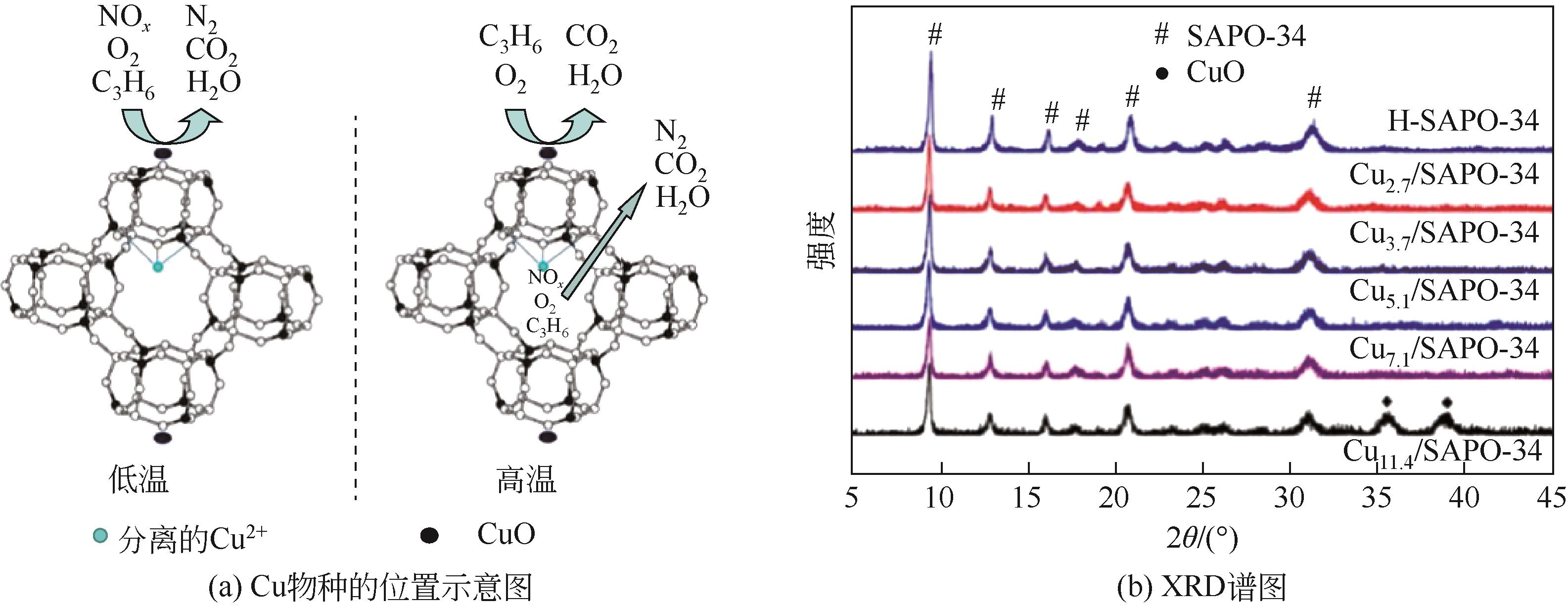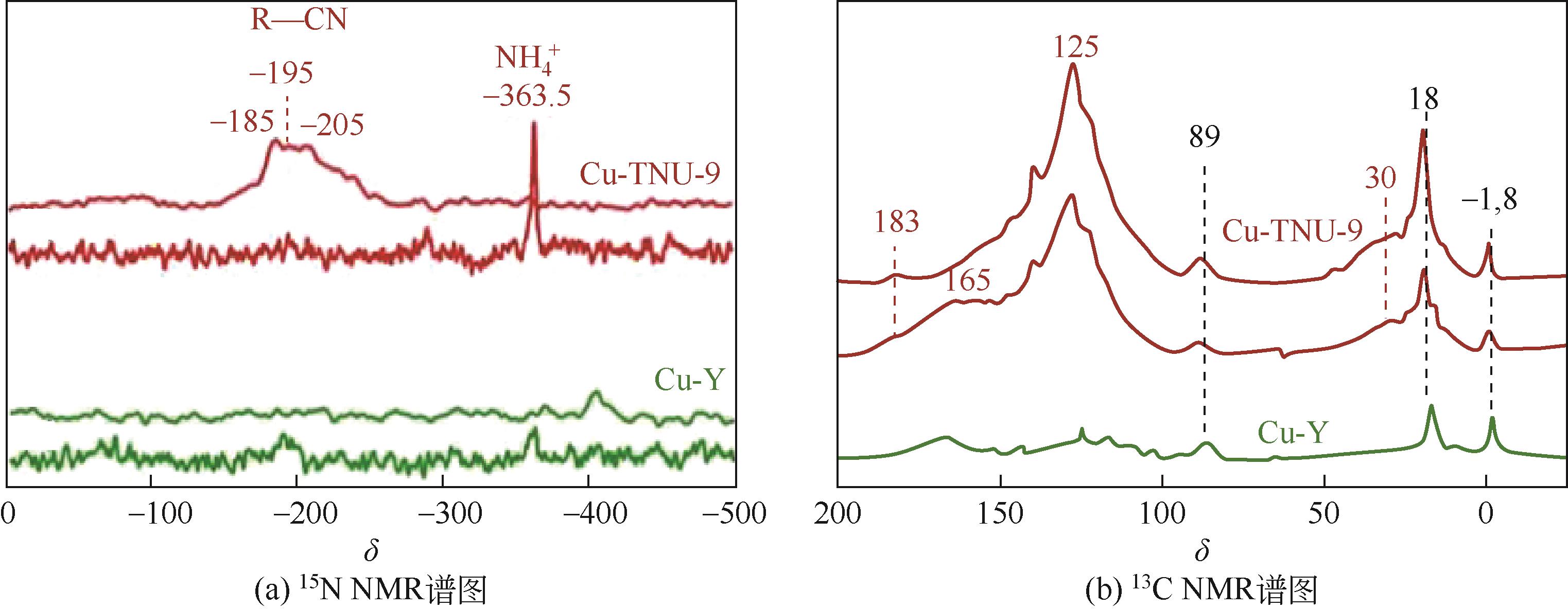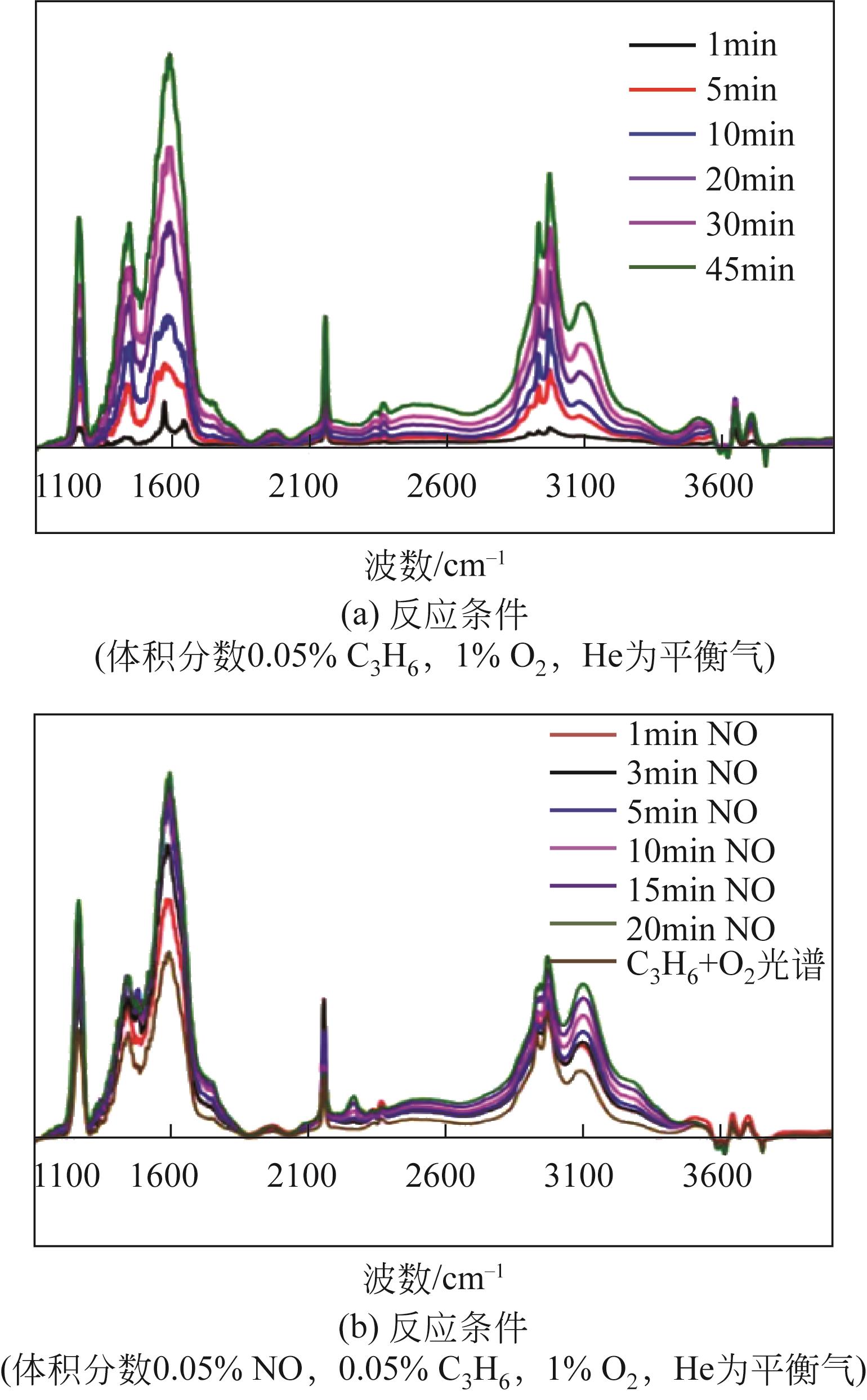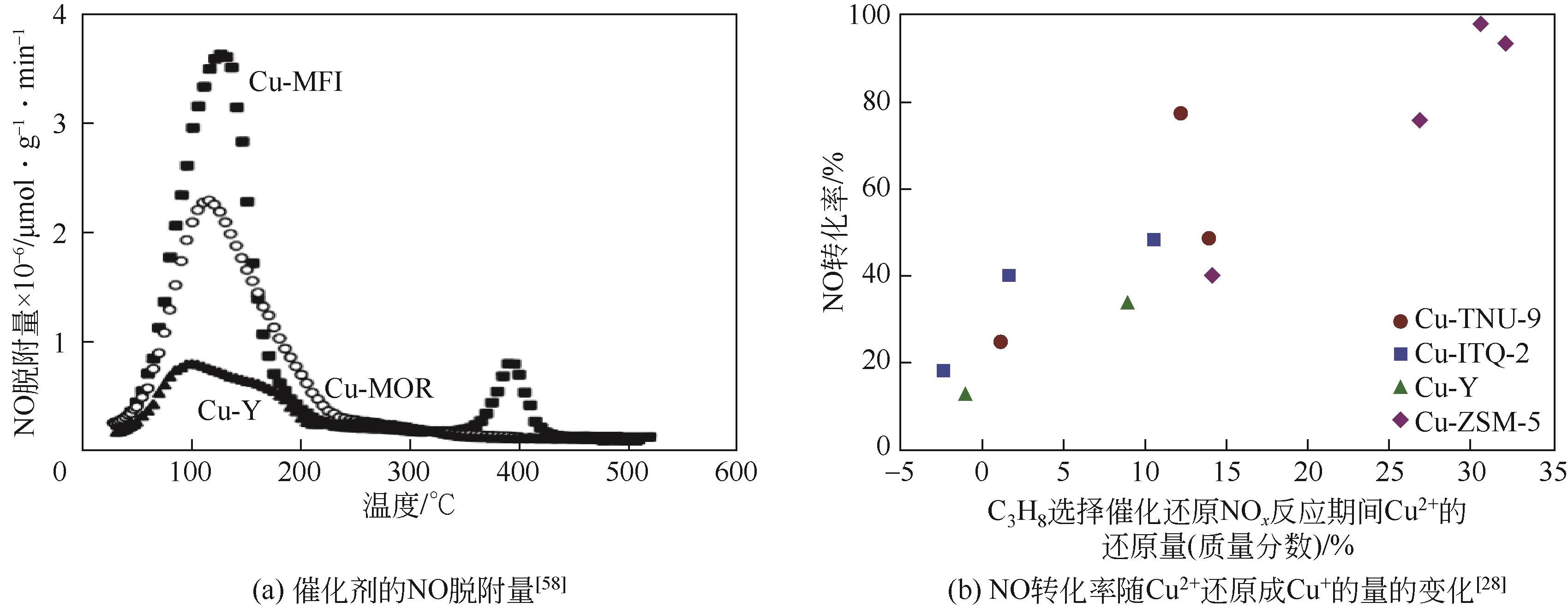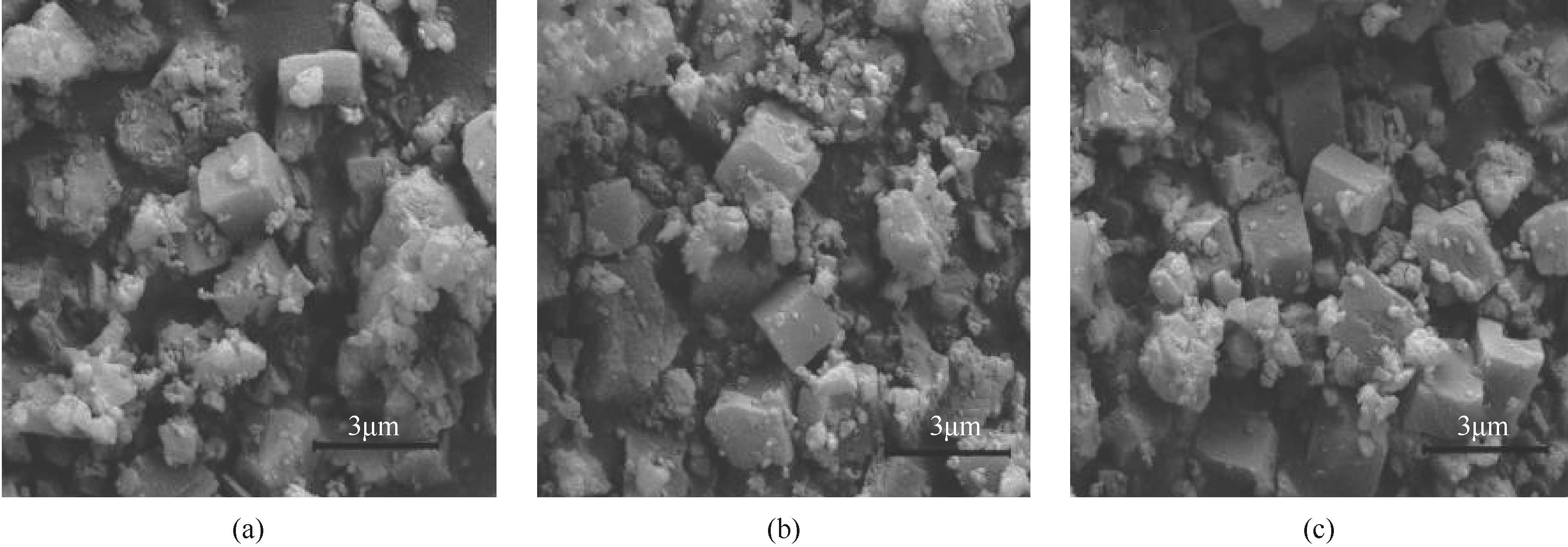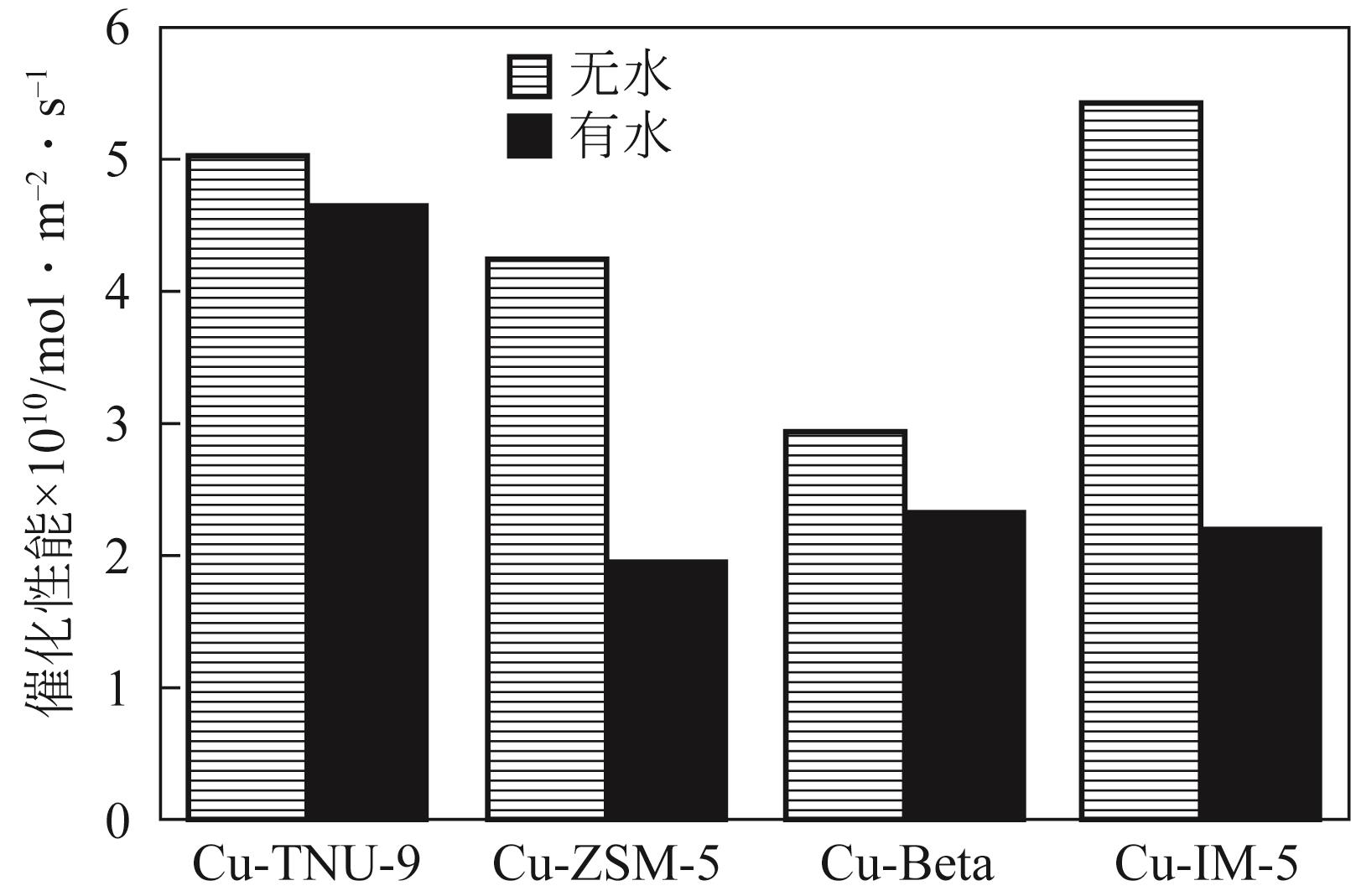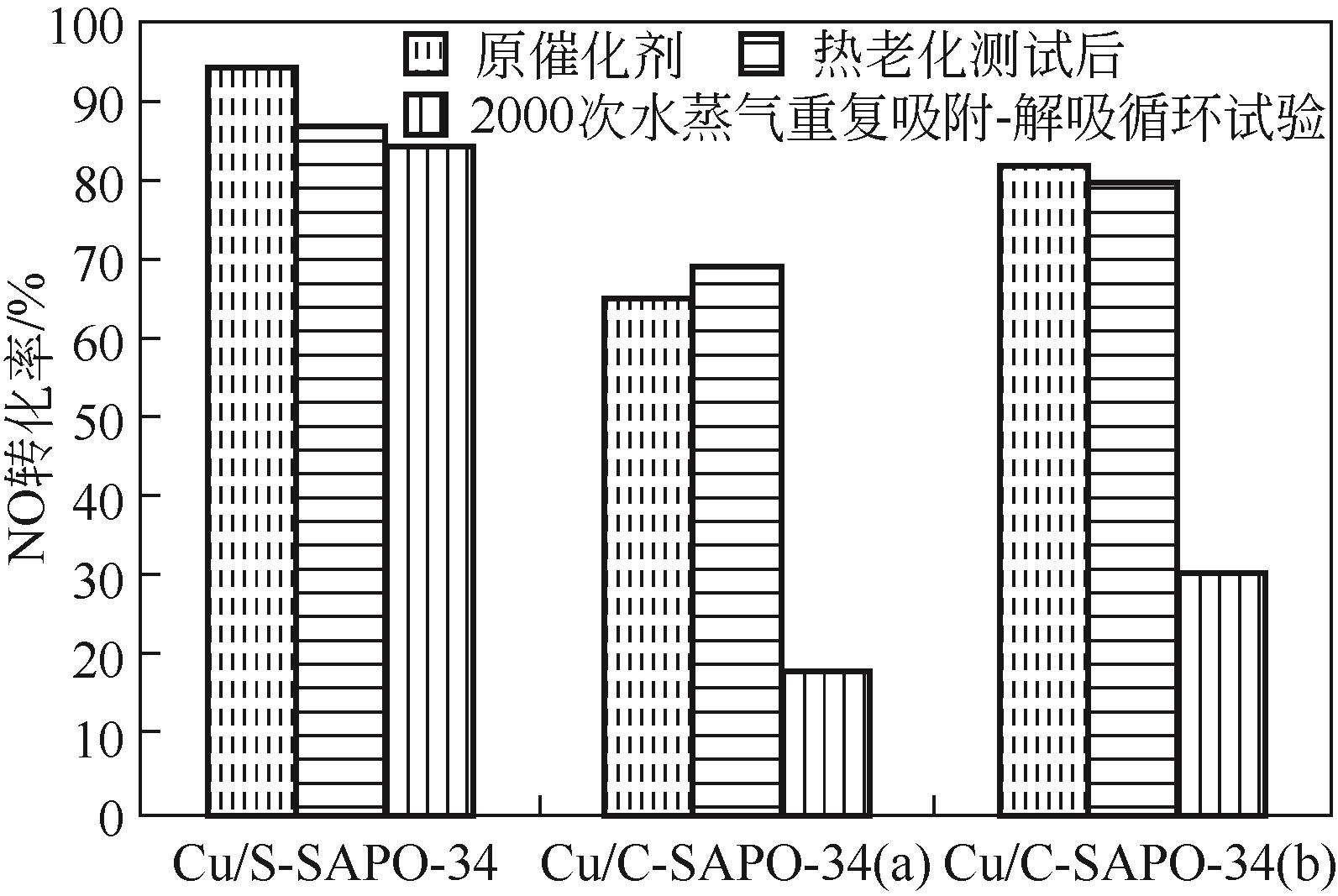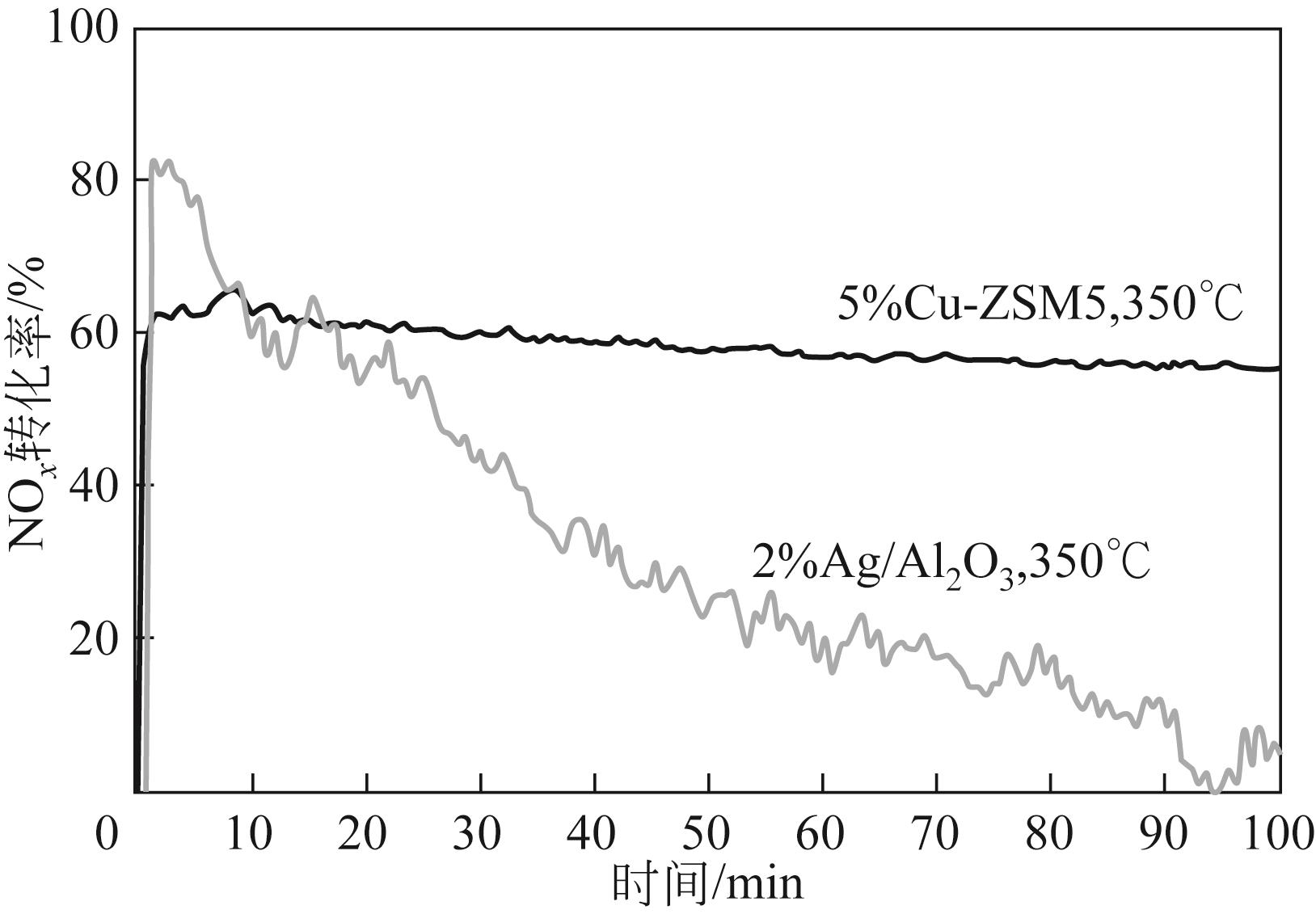Chemical Industry and Engineering Progress ›› 2023, Vol. 42 ›› Issue (3): 1308-1320.DOI: 10.16085/j.issn.1000-6613.2022-0931
• Industrial catalysis • Previous Articles Next Articles
Research progress on supported Cu-based zeolite catalysts for the selective catalytic reduction of NO x with hydrocarbons
NING Shuying( ), SU Yaxin(
), SU Yaxin( ), YANG Honghai, WEN Nini
), YANG Honghai, WEN Nini
- College of Environmental Science and Engineering, Donghua University, Shanghai 201620, China
-
Received:2022-05-19Revised:2022-08-23Online:2023-04-10Published:2023-03-15 -
Contact:SU Yaxin
用于HC-SCR还原NO x 的Cu基分子筛催化剂研究进展
- 东华大学环境科学与工程学院,上海 201620
-
通讯作者:苏亚欣 -
作者简介:宁淑英(1992—),女,博士研究生,研究方向为燃烧污染物控制。E-mail:18366185410@163.com。 -
基金资助:国家自然科学基金(52276103)
CLC Number:
Cite this article
NING Shuying, SU Yaxin, YANG Honghai, WEN Nini. Research progress on supported Cu-based zeolite catalysts for the selective catalytic reduction of NO x with hydrocarbons[J]. Chemical Industry and Engineering Progress, 2023, 42(3): 1308-1320.
宁淑英, 苏亚欣, 杨洪海, 温妮妮. 用于HC-SCR还原NO x 的Cu基分子筛催化剂研究进展[J]. 化工进展, 2023, 42(3): 1308-1320.
share this article
Add to citation manager EndNote|Ris|BibTeX
URL: https://hgjz.cip.com.cn/EN/10.16085/j.issn.1000-6613.2022-0931
| 1 | ZHANG Zhiping, LI Yingying, YANG Piaoping, et al. Improved NH3-SCR deNO x activity and tolerance to H2O & SO2 at low temperature over the Nb m Cu0.1- m Ce0.9O x catalysts: role of acidity by niobium doping[J]. Fuel, 2021, 303: 121239. |
| 2 | HALEPOTO A, KASHIF M, SU Y X, et al. Preparations and characterization on Fe based catalyst supported on coconut shell activated carbon CS(AC) and SCR of NO x -HC[J]. Catalysis Surveys from Asia, 2020, 24(2): 123-133. |
| 3 | XU Junqiang, TANG Tian, ZHANG Qiang, et al. Remarkable low temperature catalytic activity for SCR of NO with propylene under oxygen-rich conditions over Mn0.2La0.07Ce0.05O x /ZSM-5 catalyst[J]. Vacuum, 2021, 188: 110174. |
| 4 | SÁNCHEZ-LÓPEZ P, KOTOLEVICH Y, MIRIDONOV S, et al. Bimetallic AgFe systems on mordenite: effect of cation deposition order in the NO reduction with C3H6/CO[J]. Catalysts, 2019, 9(1): 58. |
| 5 | PIETRZYK P, GÓRA-MAREK K, MAZUR T, et al. Structure and mechanistic relevance of Ni2+-NO adduct in model HC SCR reaction over NiZSM-5 catalyst - insights from standard and correlation EPR and IR spectroscopic studies corroborated by molecular modeling[J]. Journal of Catalysis, 2021, 394: 206-219. |
| 6 | LEE K, CHOI B. HC-SCR system combining Ag/Al2O3 and Pd/Al2O3 catalysts with resistance to hydrothermal aging for simultaneous removal of NO, HC, and CO[J]. Journal of Industrial and Engineering Chemistry, 2021, 102: 51-68. |
| 7 | WANG Jie, SHAN Junwei, TIAN Yajie, et al. Catalytic cracking of n-heptane over Fe modified HZSM-5 nanosheet to produce light olefins[J]. Fuel, 2021, 306: 121725. |
| 8 | LEE K, CHOI B, KIM C, et al. De-NO x characteristics of HC-SCR system employing combined Ag/Al2O3 and CuSn/ZSM-5 catalyst[J]. Journal of Industrial and Engineering Chemistry, 2021, 93: 461-475. |
| 9 | 宁汝亮, 刘霄龙, 朱廷钰. 低温SCR脱硝催化剂研究进展[J]. 过程工程学报, 2019, 19(2): 223-234. |
| NING Ruliang, LIU Xiaolong, ZHU Tingyu. Research progress of low-temperature SCR denitration catalysts[J]. The Chinese Journal of Process Engineering, 2019, 19(2): 223-234. | |
| 10 | 赵跃飞, 闫涛涛, 陈凯, 等. Mn掺杂对尖晶石型NiFe1.97Pd0.03O4- δ 催化剂脱硝性能的影响[J]. 化工进展, 2020, 39(2): 577-583. |
| ZHAO Yuefei, YAN Taotao, CHEN Kai, et al. Effect of Mn-doped spinel catalyst NiFe1.97Pd0.03O4- δ on catalytic performance for SCR[J]. Chemical Industry and Engineering Progress, 2020, 39(2): 577-583. | |
| 11 | PRASAD V S, AGHALAYAM P. Microkinetic modeling of HC-SCR of NO to N2, N2O, and NO2 on Pt catalysts in automotive aftertreatment[J]. Industrial & Engineering Chemistry Research, 2017, 56(41): 11705-11712. |
| 12 | LEE K, KOSAKA H, SATO S, et al. Effects of Cu loading and zeolite topology on the selective catalytic reduction with C3H6 over Cu/zeolite catalysts[J]. Journal of Industrial and Engineering Chemistry, 2019, 72: 73-86. |
| 13 | LIU Fang, YANG Li, CHENG Jie, et al. Low temperature deNO x catalytic activity with C2H4 as a reductant using mixed metal Fe-Mn oxides supported on activated carbon[J]. Energies, 2019, 12(22): 4341. |
| 14 | DEKA D J, DAYA R, LADSHAW A, et al. Assessing impact of real-world aging on Cu-redox half cycles of a Cu-SSZ-13 SCR catalyst via transient response measurements and kinetic modeling[J]. Applied Catalysis B: Environmental, 2022, 309: 121233. |
| 15 | WEN Nini, LIN Rui, SU Yaxin, et al. SCR of NO with CH4 over Fe/Ga2O3-Al2O3 and the mechanism[J]. Journal of Environmental Chemical Engineering, 2021, 9(1): 105014. |
| 16 | ŁAMACZ A, KRZTOŃ A, DJÉGA-MARIADASSOU G. Study on the selective catalytic reduction of NO with toluene over CuO/CeZrO2. A confirmation for the three-function model of HC-SCR using the temperature programmed methods and in situ DRIFTS[J]. Applied Catalysis B: Environmental, 2013, 142/143: 268-277. |
| 17 | 周皞, 张恒, 温妮妮, 等. Cu-SAPO-44分子筛的制备及其C3H6-SCR脱硝性能[J]. 化工进展, 2023, 42(3): 1374-1383. |
| ZHOU Hao, ZHANG Heng, WEN Nini,et al. Preparation and de-NO x performance of C3H6-SCR over Cu-SAPO-44 catalyst[J]. Chemical Industry and Engineering Progress, 2023, 42(3): 1374-1383. | |
| 18 | GHOLAMI F, TOMAS M, GHOLAMI Z, et al. Technologies for the nitrogen oxides reduction from flue gas: a review[J]. Science of the Total Environment, 2020, 714: 136712. |
| 19 | YANG Zhi, DONG Anqi, CHEN Haijun. Cu/zeolite catalysts for the photocatalytic decomposition and selective catalytic reduction of NO x [J]. Research on Chemical Intermediates, 2017, 43(9): 5245-5259. |
| 20 | NGUYEN V T, NGUYEN D B, HEO I, et al. Evaluation of low-temperature NO x removal over Ag/ZSM5 and Cu/ZSM5 catalysts coupled with plasma[J]. IEEE Transactions on Plasma Science, 2020, 48(7): 2448-2456. |
| 21 | 胡宜康, 徐斌, 曹智焜, 等. Cu基分子筛催化剂抗中毒性能的研究进展[J]. 应用化工, 2020, 49(1): 171-176. |
| HU Yikang, XU Bin, CAO Zhikun, et al. Research progress on the poisoning resistance properties of Cu-based zeolite catalysts[J]. Applied Chemical Industry, 2020, 49(1): 171-176. | |
| 22 | YAHIRO H, IWAMOTO M. Copper ion-exchanged zeolite catalysts in deNO x reaction[J]. Applied Catalysis A: General, 2001, 222(1/2): 163-181. |
| 23 | CASTELLANOS I, MARIE O. Fe-HFER and Cu-HFER as catalysts for the NO x SCR using acetylene as a reducing agent: reaction mechanism revealed by FT-IR operando study coupled with 15NO isotopic labelling[J]. Applied Catalysis B: Environmental, 2018, 223: 143-153. |
| 24 | TORTORELLI M, CHAKAROVA K, LISI L, et al. Disproportionation of associated Cu2+ sites in Cu-ZSM-5 to Cu+ and Cu3+ and FTIR detection of Cu3+(NO) x (x = 1, 2) species[J]. Journal of Catalysis, 2014, 309: 376-385. |
| 25 | YANG Li, JIA Yuanyuan, CHENG Jie, et al. Deactivation mechanism of activated carbon supported copper oxide SCR catalysts in C2H4 reductant[J]. The Canadian Journal of Chemical Engineering, 2019, 97(10): 2708-2716. |
| 26 | Feng BIN, SONG Chonglin, Gang LYU, et al. Selective catalytic reduction of nitric oxide with ammonia over zirconium-doped copper/ZSM-5 catalysts[J]. Applied Catalysis B: Environmental, 2014, 150/151: 532-543. |
| 27 | KOMVOKIS V G, ILIOPOULOU E F, VASALOS I A, et al. Development of optimized Cu-ZSM-5 deNO x catalytic materials both for HC-SCR applications and as FCC catalytic additives[J]. Applied Catalysis A: General, 2007, 325(2): 345-352. |
| 28 | MORENO-GONZÁLEZ M, PALOMARES A E, CHIESA M, et al. Evidence of a Cu2+-alkane interaction in Cu-zeolite catalysts crucial for the selective catalytic reduction of NO x with hydrocarbons[J]. ACS Catalysis, 2017, 7(5): 3501-3509. |
| 29 | LI Landong, GUAN Naijia. HC-SCR reaction pathways on ion exchanged ZSM-5 catalysts[J]. Microporous and Mesoporous Materials, 2009, 117(1/2): 450-457. |
| 30 | KORHONEN S T, FICKEL D W, LOBO R F, et al. Isolated Cu2+ ions: active sites for selective catalytic reduction of NO[J]. Chemical Communications, 2011, 47(2): 800-802. |
| 31 | FRANCH-MARTÍ C, ALONSO-ESCOBAR C, JORDA J L, et al. TNU-9, a new zeolite for the selective catalytic reduction of NO: an in situ X-ray absorption spectroscopy study[J]. Journal of Catalysis, 2012, 295: 22-30. |
| 32 | ITADANI A, YUMURA T, OHKUBO T, et al. Existence of dual species composed of Cu+ in CuMFI being bridged by C2H2 [J]. Physical Chemistry Chemical Physics, 2010, 12(24): 6455-6465. |
| 33 | NISHIGUCHI H, KIMURA S, ISHIHARA T, et al. Selective reduction of NO x with C3H6 over Cu incorporated into silicoalumino-phosphate (SAPO)[J]. Research on Chemical Intermediates, 1998, 24(4): 391-399. |
| 34 | GAO Zhongnan, ZHAO Dongyue, YANG Yuexi, et al. Influence of copper locations on catalytic properties and activities of Cu/SAPO-34 in C3H6-SCR[J]. Industrial & Engineering Chemistry Research, 2021, 60(19): 6940-6949. |
| 35 | ČAPEK L, NOVOVESKÁ K, SOBALÍK Z, et al. Cu-ZSM-5 zeolite highly active in reduction of NO with decane under water vapor presence: comparison of decane, propane and propene by in situ FTIR[J]. Applied Catalysis B: Environmental, 2005, 60(3/4): 201-210. |
| 36 | SATO S, YU-U Y, YAHIRO H, et al. Cu-ZSM-5 zeolite as highly active catalyst for removal of nitrogen monoxide from emission of diesel engines[J]. Applied Catalysis, 1991, 70(1): L1-L5. |
| 37 | SU Yaxin, WEN Nini, CHENG Jianghao, et al. Experimental study on SCR-C3H6 over Cu-Fe/Al-PILC catalysts: catalytic performance, characterization, and mechanism[J]. Industrial & Engineering Chemistry Research, 2020, 59(33): 14776-14788. |
| 38 | YANG Wei, ZHANG Runduo, CHEN Biaohua, et al. New aspects on the mechanism of C3H6 selective catalytic reduction of NO in the presence of O2 over LaFe1- x (Cu, Pd) x O3- δ perovskites[J]. Environmental Science & Technology, 2012, 46(20): 11280-11288. |
| 39 | XU Junqiang, WANG Honglin, GUO Fang, et al. Recent advances in supported molecular sieve catalysts with wide temperature range for selective catalytic reduction of NO x with C3H6 [J]. RSC Advances, 2019, 9(2): 824-838. |
| 40 | FU Mengfan, LI Caiting, LU Pei, et al. A review on selective catalytic reduction of NO x by supported catalysts at 100~300℃ —catalysts, mechanism, kinetics[J]. Catal. Sci. Technol., 2014, 4(1): 14-25. |
| 41 | MRAD R, AISSAT A, COUSIN R, et al. Catalysts for NO x selective catalytic reduction by hydrocarbons (HC-SCR)[J]. Applied Catalysis A: General, 2015, 504: 542-548. |
| 42 | CANT N W, LIU I O Y. The mechanism of the selective reduction of nitrogen oxides by hydrocarbons on zeolite catalysts[J]. Catalysis Today, 2000, 63(2/3/4): 133-146. |
| 43 | SADYKOV V, LUNIN V, MATYSHAK V, et al. The reaction mechanism of selective catalytic reduction of nitrogen oxides by hydrocarbons in excess oxygen: intermediates, their reactivity, and routes of transformation[J]. Kinetics and Catalysis, 2003, 44(3): 379-400. |
| 44 | LI Landong, ZHANG Fuxiang, GUAN Naijia, et al. Selective catalytic reduction of NO by propane in excess oxygen over IrCu-ZSM-5 catalyst[J]. Catalysis Communications, 2007, 8(3): 583-588. |
| 45 | SCHAY Z, GUCZI L, BECK A, et al. DeNO x reactions on Cu-zeolites: decomposition of NO, N2O and SCR of NO by C3H8 and CH4 on Cu-ZSM-5 and Cu-AlTS-1 catalysts[J]. Catalysis Today, 2002, 75(1/2/3/4): 393-399. |
| 46 | YASHNIK S, ISMAGILOV Z. Cu-substituted ZSM-5 catalyst: controlling of DeNO x reactivity via ion-exchange mode with copper-ammonia solution[J]. Applied Catalysis B: Environmental, 2015, 170/171: 241-254. |
| 47 | RAJ R, HAROLD M P, BALAKOTAIAH V. NO inhibition effects during oxidation of propylene on Cu-chabazite catalyst: a kinetic and mechanistic study[J]. Industrial & Engineering Chemistry Research, 2013, 52(44): 15455-15465. |
| 48 | BURCH R. Knowledge and know-how in emission control for mobile applications[J]. Catalysis Reviews, 2004, 46(3/4): 271-334. |
| 49 | JANG H J, HALL W K, D'ITRI J L. Redox behavior of CuZSM-5 catalysts: FTIR investigations of reactions of adsorbed NO and CO[J]. The Journal of Physical Chemistry, 1996, 100(22): 9416-9420. |
| 50 | HADJIIVANOV K, SAUSSEY J, FREYSZ J L. FT-IR study of NO+O2 co-adsorption on H-ZSM-5: re-assignment of the 2133cm-1 band to NO+ species[J]. Catalysis Letters, 1998, 52: 103-108. |
| 51 | PARK S K, PARK Y K, PARK S E, et al. Comparison of selective catalytic reduction of NO with C3H6 and C3H8 over Cu(II)-ZSM-5 and Co(II)-ZSM-5[J]. Physical Chemistry Chemical Physics, 2000, 2(23): 5500-5509. |
| 52 | IWAMOTO M, YAHIRO H. Novel catalytic decomposition and reduction of NO[J]. Catalysis Today, 1994, 22(1): 5-18. |
| 53 | PALOMARES A E, FRANCH C, CORMA A. Determining the characteristics of a Co-zeolite to be active for the selective catalytic reduction of NO x with hydrocarbons[J]. Catalysis Today, 2011, 176(1): 239-241. |
| 54 | FICKEL D W, D’ADDIO E, LAUTERBACH J A, et al. The ammonia selective catalytic reduction activity of copper-exchanged small-pore zeolites[J]. Applied Catalysis B: Environmental, 2011, 102(3/4): 441-448. |
| 55 | HUN K J, ZHU H Y, LEE J H, et al. Two different cationic positions in Cu-SSZ-13?[J]. Chemical Communications, 2012, 48(39): 4758-4760. |
| 56 | LIU Fudong, YU Yunbo, HE Hong. Environmentally-benign catalysts for the selective catalytic reduction of NO x from diesel engines: structure-activity relationship and reaction mechanism aspects[J]. Chemical Communications, 2014, 50(62): 8445-8463. |
| 57 | ISHIHARA T, KAGAWA M, HADAMA F, et al. Copper ion-exchanged SAPO-34 as a thermostable catalyst for selective reduction of NO with C3H6 [J]. Journal of Catalysis, 1997, 169(1): 93-102. |
| 58 | TORRE-ABREU C, HENRIQUES C, RIBEIRO F R, et al. Selective catalytic reduction of NO on copper-exchanged zeolites: the role of the structure of the zeolite in the nature of copper-active sites[J]. Catalysis Today, 1999, 54(4): 407-418. |
| 59 | HE Donglin, ZHANG Huiping, YAN Ying. Preparation of Cu-ZSM-5 catalysts by chemical vapour deposition for catalytic wet peroxide oxidation of phenol in a fixed bed reactor[J]. Royal Society Open Science, 2018, 5(4): 172364. |
| 60 | TORRE-ABREU C, RIBEIRO M F, HENRIQUES C, et al. Selective catalytic reduction of NO with propene over CuMFI zeolites: dependence on Si/Al ratio and copper loading[J]. Applied Catalysis B: Environmental, 1997, 11(3/4): 383-401. |
| 61 | 周微, 王福烨, 贺宁, 等. Cu/SSZ-13催化剂脱硝活性中心与催化性能构效关系的研究[J]. 化工学报, 2022, 73(2): 672-680. |
| ZHOU Wei, WANG Fuye, HE Ning, et al. Study on the relationship of active centers and catalytic performance of Cu/SSZ-13 for NH3-SCR[J]. CIESC Journal, 2022, 73(2): 672-680. | |
| 62 | CHENG Jin, HAN Shuai, YE Qing, et al. Selective catalytic reduction of NO with NH3 over the Cu/SAPO-34 catalysts derived from different Cu precursors[J]. Microporous and Mesoporous Materials, 2019, 278: 423-434. |
| 63 | 孟鹏通, 范超, 吕文婷, 等. 整体式堇青石负载的Cu-SSZ-13分子筛催化剂的制备及其氨选择性催化还原脱硝性能[J]. 燃料化学学报, 2020, 48(10): 1216-1223. |
| MENG Pengtong, FAN Chao, Wenting LYU, et al. Preparation of monolithic cordierite supported Cu-SSZ-13 catalyst and its performance in the selective catalytic reduction of NO x with NH3 [J]. Journal of Fuel Chemistry and Technology, 2020, 48(10): 1216-1223. | |
| 64 | PEREDA-AYO B, DE LA TORRE U, ROMERO-SÁEZ M, et al. Influence of the washcoat characteristics on NH3-SCR behavior of Cu-zeolite monoliths[J]. Catalysis Today, 2013, 216: 82-89. |
| 65 | DE LA TORRE U, PEREDA-AYO B, GONZÁLEZ-VELASCO J R. Cu-zeolite NH3-SCR catalysts for NO x removal in the combined NSR-SCR technology[J]. Chemical Engineering Journal, 2012, 207/208: 10-17. |
| 66 | JABŁOŃSKA M, GÓRA-MAREK K, GRILC M, et al. Effect of textural properties and presence of co-cation on NH3-SCR activity of Cu-exchanged ZSM-5[J]. Catalysts, 2021, 11(7): 843. |
| 67 | CHENG Jie, ZHENG Dahai, DAI Chengna, et al. Constructing active copper species in Cu-zeolites for coal-gas-SCR and elucidating the synergistic catalytic function of CuO and Cu2+ ion species[J]. Environmental Science: Nano, 2022, 9(7): 2372-2387. |
| 68 | CHEN Peirong, SIMBÖCK J, SCHÖNEBAUM S, et al. Monitoring NH3 storage and conversion in Cu-ZSM-5 and Cu-SAPO-34 catalysts for NH3-SCR by simultaneous impedance and DRIFT spectroscopy[J]. Sensors and Actuators B: Chemical, 2016, 236: 1075-1082. |
| 69 | RUTKOWSKA M, PACIA I, BASĄG S, et al. Catalytic performance of commercial Cu-ZSM-5 zeolite modified by desilication in NH3-SCR and NH3-SCO processes[J]. Microporous and Mesoporous Materials, 2017, 246: 193-206. |
| 70 | GÜNTER T, PESEK J, SCHÄFER K, et al. Cu-SSZ-13 as pre-turbine NO x -removal-catalyst: impact of pressure and catalyst poisons[J]. Applied Catalysis B: Environmental, 2016, 198: 548-557. |
| 71 | LA TORRE U, PEREDA-AYO B, ROMERO-SÁEZ M, et al. Screening of Fe-Cu-zeolites prepared by different methodology for application in NSR-SCR combined DeNO x systems[J]. Topics in Catalysis, 2013, 56(1/2/3/4/5/6/7/8): 215-221. |
| 72 | ZUO Yongquan, HAN Lina, BAO Weiren, et al. Effect of CuSAPO-34 catalyst preparation method on NO x removal from diesel vehicle exhausts[J]. Chinese Journal of Catalysis, 2013, 34(6): 1112-1122. |
| 73 | JODŁOWSKI P J, CHLEBDA D, PIWOWARCZYK E, et al. In situ and operando spectroscopic studies of sonically aided catalysts for biogas exhaust abatement[J]. Journal of Molecular Structure, 2016, 1126: 132-140. |
| 74 | JIN Ruiben, LIU Yue, WU Zhongbiao, et al. Low-temperature selective catalytic reduction of NO with NH3 over MnCe oxides supported on TiO2 and Al2O3: A comparative study[J]. Chemosphere, 2010, 78(9): 1160-1166. |
| 75 | BANG J H, SUSLICK K S. Applications of ultrasound to the synthesis of nanostructured materials[J]. Advanced Materials, 2010, 22(10): 1039-1059. |
| 76 | ANDAÇ Ö, MURAT TELLI Ş, TATLIER M, et al. Effects of ultrasound on the preparation of zeolite A coatings[J]. Microporous and Mesoporous Materials, 2006, 88(1/2/3): 72-76. |
| 77 | JODŁOWSKI P J, CZEKAJ I, STACHURSKA P, et al. Experimental and theoretical studies of sonically prepared Cu-Y, Cu-USY and Cu-ZSM-5 catalysts for SCR deNO x [J]. Catalysts, 2021, 11(7): 824. |
| 78 | LI Landong, CHEN Jixin, ZHANG Shujuan, et al. Selective catalytic reduction of nitrogen oxides from exhaust of lean burn engine over in situ synthesized monolithic Cu-TS-1/cordierite[J]. Catalysis Today, 2004, 90(3/4): 207-213. |
| 79 | DANG T T H, ZUBOWA H L, BENTRUP U, et al. Microwave-assisted synthesis and characterization of Cu-containing AlPO4-5 and SAPO-5[J]. Microporous and Mesoporous Materials, 2009, 123(1/2/3): 209-220. |
| 80 | ZHUKOV Y M, SHELYAPINA M G, ZVEREVA I A, et al. Microwave assisted versus convention Cu2+ exchange in mordenite[J]. Microporous and Mesoporous Materials, 2018, 259: 220-228. |
| 81 | ZHUKOV Y M, EFIMOV A Y, SHELYAPINA M G, et al. Effect of preparation method on the valence state and encirclement of copper exchange ions in mordenites[J]. Microporous and Mesoporous Materials, 2016, 224: 415-419. |
| 82 | GRAMIGNI F, IACOBONE U, NASELLO N D, et al. Review of hydrocarbon poisoning and deactivation effects on Cu-zeolite, Fe-zeolite, and vanadium-based selective catalytic reduction catalysts for NO x removal from lean exhausts[J]. Industrial & Engineering Chemistry Research, 2021, 60(18): 6403-6420. |
| 83 | ZENGEL D, BARTH S, CASAPU M, et al. The impact of pressure and hydrocarbons on NO x abatement over Cu- and Fe-zeolites at pre-turbocharger position[J]. Catalysts, 2021, 11(3): 336. |
| 84 | OTTINGER N, VEELE R, XI Y Z, et al. Conversion of short-chain alkanes by vanadium-based and Cu/zeolite SCR catalysts[J]. SAE International Journal of Engines, 2016, 9(2): 1241-1246. |
| 85 | ZHENG L, CASAPU M, STEHLE M, et al. Selective catalytic reduction of NO x with ammonia and hydrocarbon oxidation over V2O5-MoO3/TiO2 and V2O5-WO3/TiO2 SCR catalysts[J]. Topics in Catalysis, 2019, 62(1/2/3/4): 129-139. |
| 86 | ZHENG L, ZIMINA A, CASAPU M, et al. Hydrocarbon and soot oxidation over cerium and iron doped vanadium SCR catalysts[J]. ChemCatChem, 2020, 12(24): 6272-6284. |
| 87 | LUO J Y, YEZERETS A, HENRY C, et al. Hydrocarbon poisoning of Cu-zeolite SCR catalysts[C]// SAE Technical Paper Series. 400 Commonwealth Drive, Warrendale, PA, United States: SAE International, 2012. |
| 88 | LUO J Y, OH H, HENRY C, et al. Effect of C3H6 on selective catalytic reduction of NO x by NH3 over a Cu/zeolite catalyst: a mechanistic study[J]. Applied Catalysis B: Environmental, 2012, 123/124: 296-305. |
| 89 | SULTANA A, NANBA T, SASAKI M, et al. Selective catalytic reduction of NO x with NH3 over different copper exchanged zeolites in the presence of decane[J]. Catalysis Today, 2011, 164(1): 495-499. |
| 90 | MA Lei, LI Junhua, CHENG Yisun, et al. Propene poisoning on three typical Fe-zeolites for SCR of NO x with NH₃: from mechanism study to coating modified architecture[J]. Environmental Science & Technology, 2012, 46(3): 1747-1754. |
| 91 | YE Q, WANG L F, YANG R T. Activity, propene poisoning resistance and hydrothermal stability of copper exchanged chabazite-like zeolite catalysts for SCR of NO with ammonia in comparison to Cu/ZSM-5[J]. Applied Catalysis A: General, 2012, 427/428: 24-34. |
| 92 | BOUTROS M, ONFROY T, COSTA P DA. Mesostructured or alumina-mesostructured silica SBA-16 as potential support for NO x reduction and ethanol oxidation[J]. Catalysis Letters, 2010, 139(1/2): 50-55. |
| 93 | DZWIGAJ S, JANAS J, GURGUL J, et al. Do Cu(Ⅱ) ions need Al atoms in their environment to make CuSiBEA active in the SCR of NO by ethanol or propane? A spectroscopy and catalysis study[J]. Applied Catalysis B: Environmental, 2009, 85(3/4): 131-138. |
| 94 | ILIOPOULOU E F, EVDOU A P, LEMONIDOU A A, et al. Ag/alumina catalysts for the selective catalytic reduction of NO x using various reductants[J]. Applied Catalysis A: General, 2004, 274(1/2): 179-189. |
| 95 | BOUTROS M, GÁLVEZ M E, ONFROY T, et al. Influence of synthesis parameters of SBA-15 supported palladium catalysts for methane combustion and simultaneous NO x reduction[J]. Microporous and Mesoporous Materials, 2014, 183: 1-8. |
| 96 | RODRIGUES A, COSTA P DA, MÉTHIVIER C, et al. Controlled preparation of CoPdSiBEA zeolite catalysts for selective catalytic reduction of NO with methane and their characterisation by XRD, DR UV-vis, TPR, XPS[J]. Catalysis Today, 2011, 176(1): 72-76. |
| 97 | SEYEDEYN-AZAD F, ZHANG D K. Selective catalytic reduction of nitric oxide over Cu and Co ion-exchanged ZSM-5 zeolite: the effect of SiO2/Al2O3 ratio and cation loading[J]. Catalysis Today, 2001, 68(1/2/3): 161-171. |
| 98 | CABALLERO A, MORALES J J, CORDON A M, et al. An in situ XAS study of Cu/ZrO2 catalysts under de-NO x reaction conditions[J]. Journal of Catalysis, 2005, 235(2): 295-301. |
| 99 | ESPINÓS J P, MORALES J, BARRANCO A, et al. Interface effects for Cu, CuO, and Cu2O deposited on SiO2 and ZrO2. XPS determination of the valence state of copper in Cu/SiO2 and Cu/ZrO2 catalysts[J]. The Journal of Physical Chemistry B, 2002, 106(27): 6921-6929. |
| 100 | ANSELL G P, DIWELL A F, GOLUNSKI S E, et al. Mechanism of the lean NO x reaction over Cu/ZSM-5[J]. Applied Catalysis B: Environmental, 1993, 2(1): 81-100. |
| 101 | HOUEL V, JAMES D, MILLINGTON P, et al. A comparison of the activity and deactivation of Ag/Al2O3 and Cu/ZSM-5 for HC-SCR under simulated diesel exhaust emission conditions[J]. Journal of Catalysis, 2005, 230(1): 150-157. |
| 102 | HAN J, WANG A Y, ISAPOUR G, et al. N2O formation during NH3-SCR over different zeolite frameworks: effect of framework structure, copper species, and water[J]. Industrial & Engineering Chemistry Research, 2021, 60(49): 17826-17839. |
| 103 | GUO Mingyu, LIU Qingling, LIU Caixia, et al. Rational design of novel CrZrOx catalysts for efficient low temperature SCR of NO x [J]. Chemical Engineering Journal, 2021, 413: 127554. |
| 104 | 王聪颖, 周皞, 杨迪, 等. 一步水热合成Cu-SSZ-13分子筛选择性催化C3H6还原NO[J]. 无机化学学报, 2021, 37(5): 853-866. |
| WANG Congying, ZHOU Hao, YANG Di, et al. Selective catalytic reduction of NO with C3H6 over one-step hydrothermal synthesized Cu-SSZ-13 catalysts[J]. Chinese Journal of Inorganic Chemistry, 2021, 37(5): 853-866. | |
| 105 | 毛静雯, 徐斌, 胡宜康, 等. Ce金属改性对Cu-SAPO-34催化剂水热稳定性能的影响[J]. 燃料化学学报, 2020, 48(10): 1208-1215. |
| MAO Jingwen, XU Bin, HU Yikang, et al. Effect of Ce metal modification on the hydrothermal stability of Cu-SAPO-34 catalyst[J]. Journal of Fuel Chemistry and Technology, 2020, 48(10): 1208-1215. | |
| 106 | OKADA O, TABATA T, KOKITSU M, et al. Advanced catalyst for NO x reduction using hydrocarbons from lean-burning gas engine[J]. Applied Surface Science, 1997, 121/122: 267-272. |
| 107 | CHAJAR Z, DENTON P, DE BERNARD F B, et al. Influence of silver on the catalytic activity of Cu-ZSM-5 for NO SCR by propane. Effect of the presence of water and hydrothermal agings[J]. Catalysis Letters, 1998, 55(3/4): 217-222. |
| 108 | LEISTNER K, MIHAI O, WIJAYANTI K, et al. Comparison of Cu/BEA, Cu/SSZ-13 and Cu/SAPO-34 for ammonia-SCR reactions[J]. Catalysis Today, 2015, 258: 49-55. |
| 109 | NIU Can, SHI Xiaoyan, LIU Fudong, et al. High hydrothermal stability of Cu-SAPO-34 catalysts for the NH3-SCR of NO x [J]. Chemical Engineering Journal, 2016, 294: 254-263. |
| 110 | BRIEND M, VOMSCHEID R, PELTRE M J, et al. Influence of the choice of the template on the short- and long-term stability of SAPO-34 zeolite[J]. The Journal of Physical Chemistry, 1995, 99(20): 8270-8276. |
| 111 | SON I H, KIM M C, KOH H, et al. On the promotion of Ag/γ-Al2O3 by Cs for the SCR of NO by C3H6 [J]. Catalysis Letters, 2001, 75: 191-197. |
| 112 | BERGMAN S L, DAHLIN S, MESILOV V V, et al. In-situ studies of oxidation/reduction of copper in Cu-CHA SCR catalysts: comparison of fresh and SO 2 - poisoned catalysts[J]. Applied Catalysis B: Environmental, 2020, 269: 118722. |
| 113 | DAHLIN S, LANTTO C, ENGLUND J, et al. Chemical aging of Cu-SSZ-13 SCR catalysts for heavy-duty vehicles - influence of sulfur dioxide[J]. Catalysis Today, 2019, 320: 72-83. |
| 114 | SHAN Yulong, SHI Xiaoyan, YAN Zidi, et al. Deactivation of Cu-SSZ-13 in the presence of SO2 during hydrothermal aging[J]. Catalysis Today, 2019, 320: 84-90. |
| 115 | YUE Yuanyuan, LIU Ben, QIN Peng, et al. One-pot synthesis of FeCu-SSZ-13 zeolite with superior performance in selective catalytic reduction of NO by NH3 from natural aluminosilicates[J]. Chemical Engineering Journal, 2020, 398: 125515. |
| [1] | LI Mengyuan, GUO Fan, LI Qunsheng. Simulation and optimization of the third and fourth distillation columns in the recovery section of polyvinyl alcohol production [J]. Chemical Industry and Engineering Progress, 2023, 42(S1): 113-123. |
| [2] | ZHANG Ruijie, LIU Zhilin, WANG Junwen, ZHANG Wei, HAN Deqiu, LI Ting, ZOU Xiong. On-line dynamic simulation and optimization of water-cooled cascade refrigeration system [J]. Chemical Industry and Engineering Progress, 2023, 42(S1): 124-132. |
| [3] | WANG Fu'an. Consumption and emission reduction of the reactor of 300kt/a propylene oxide process [J]. Chemical Industry and Engineering Progress, 2023, 42(S1): 213-218. |
| [4] | SHI Yongxing, LIN Gang, SUN Xiaohang, JIANG Weigeng, QIAO Dawei, YAN Binhang. Research progress on active sites in Cu-based catalysts for CO2 hydrogenation to methanol [J]. Chemical Industry and Engineering Progress, 2023, 42(S1): 287-298. |
| [5] | WANG Zhengkun, LI Sifang. Green synthesis of gemini surfactant decyne diol [J]. Chemical Industry and Engineering Progress, 2023, 42(S1): 400-410. |
| [6] | WANG Lele, YANG Wanrong, YAO Yan, LIU Tao, HE Chuan, LIU Xiao, SU Sheng, KONG Fanhai, ZHU Canghai, XIANG Jun. Influence of spent SCR catalyst blending on the characteristics and deNO x performance for new SCR catalyst [J]. Chemical Industry and Engineering Progress, 2023, 42(S1): 489-497. |
| [7] | DENG Liping, SHI Haoyu, LIU Xiaolong, CHEN Yaoji, YAN Jingying. Non-noble metal modified vanadium titanium-based catalyst for NH3-SCR denitrification simultaneous control VOCs [J]. Chemical Industry and Engineering Progress, 2023, 42(S1): 542-548. |
| [8] | LI Chunli, HAN Xiaoguang, LIU Jiapeng, WANG Yatao, WANG Chenxi, WANG Honghai, PENG Sheng. Research progress of liquid distributors in packed columns [J]. Chemical Industry and Engineering Progress, 2023, 42(9): 4479-4495. |
| [9] | LUO Cheng, FAN Xiaoyong, ZHU Yonghong, TIAN Feng, CUI Louwei, DU Chongpeng, WANG Feili, LI Dong, ZHENG Hua’an. CFD simulation of liquid distribution in different distributors in medium-low temperature coal tar hydrogenation reactor [J]. Chemical Industry and Engineering Progress, 2023, 42(9): 4538-4549. |
| [10] | WANG Yaogang, HAN Zishan, GAO Jiachen, WANG Xinyu, LI Siqi, YANG Quanhong, WENG Zhe. Strategies for regulating product selectivity of copper-based catalysts in electrochemical CO2 reduction [J]. Chemical Industry and Engineering Progress, 2023, 42(8): 4043-4057. |
| [11] | WANG Xiaohan, ZHOU Yasong, YU Zhiqing, WEI Qiang, SUN Jinxiao, JIANG Peng. Synthesis and hydrocracking performance of Y molecular sieves with different crystal sizes [J]. Chemical Industry and Engineering Progress, 2023, 42(8): 4283-4295. |
| [12] | YANG Jing, LI Bo, LI Wenjun, LIU Xiaona, TANG Liuyuan, LIU Yue, QIAN Tianwei. Degradation of naphthalene by degrading bacteria isolated from coking contaminated sites [J]. Chemical Industry and Engineering Progress, 2023, 42(8): 4351-4361. |
| [13] | LI Haidong, YANG Yuankun, GUO Shushu, WANG Benjin, YUE Tingting, FU Kaibin, WANG Zhe, HE Shouqin, YAO Jun, CHEN Shu. Effect of carbonization and calcination temperature on As(Ⅲ) removal performance of plant-based Fe-C microelectrolytic materials [J]. Chemical Industry and Engineering Progress, 2023, 42(7): 3652-3663. |
| [14] | LIU Baicheng, LI Fayun, ZHAO Qihui, LIN Meixia. Research progress on remediation of polycyclic aromatic hydrocarbons contaminated soil by Gramineae plants [J]. Chemical Industry and Engineering Progress, 2023, 42(7): 3736-3748. |
| [15] | TAN Lipeng, SHEN Jun, WANG Yugao, LIU Gang, XU Qingbai. Research progress on blending modification of coal tar pitch and petroleum asphalt [J]. Chemical Industry and Engineering Progress, 2023, 42(7): 3749-3759. |
| Viewed | ||||||
|
Full text |
|
|||||
|
Abstract |
|
|||||
